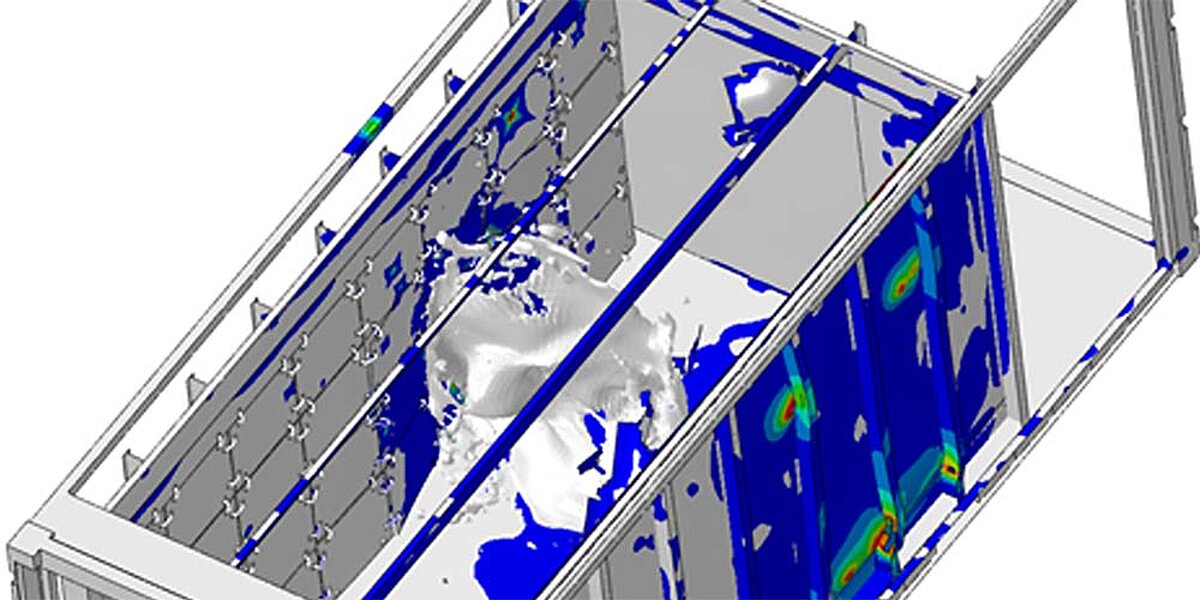Containment is thus the containment of something dangerous or unpleasant and includes the act or process of keeping the dangerous or unpleasant thing under control in a particular area or place.
Containment

For this purpose, there is also the term enclosure, that is, an enclosure or space that must not be penetrated by hazardous particles to protect the environment.
An exploding tank, a broken rotor, detached turbine blades, fragments of a grinding wheel, liquids, gases should therefore not penetrate the enclosure or test chamber during a controlled test or component failure under pressure, acceleration or centrifugal force.
Rotating parts
In the case of rotating parts, containment is understood to mean protection against failing, rapidly rotating components by means of appropriately dimensioned housings. If, for example, a grinding wheel breaks, the fragments must not leave the protective housing. This applies equally to turbochargers, engine blades, compressor blades and rotating shafts. In the case of detaching engine blades on an aircraft, the fragments must not penetrate the engine housing in order to protect the passengers and the aircraft.
Accelerated parts and fluids
These can be machine components such as robot arms, which do not leave the protected space in the event of a failure of the control system. If the robot arm hits the safety housing with a certain, defined energy, there must be no penetration. Accelerated liquids are a special case. This is used, for example, in the simulation of tank sloshing. Baffles can be used to prevent liquid from destroying the tank.
Parts under high pressure
If pumps, hoses, tanks or containers fail, e.g. during push-off or burst tests, the fragments, but also the media with which the pressure is generated (e.g. water, oil or air or gas) must remain in the test chamber, which as a rule should also not be destroyed.
The pressure vessel standards prescribe appropriate tests in test chambers here.
Bombardment
If armored vehicles or buildings are fired upon, the projectile must not reach the area to be secured. The protection of people by bulletproof vests can also be considered. Here, the bruising or breaking of ribs due to the impact can be considered.
Explosion
Explosions are a special case of pressure loads, which we can calculate using the same procedures. Here, the pressure load is described mathematically as a temporal pressure wave. This is an extension of the quasi-static pressure shock resistance test, which we can of course also cover by calculation.
Notes
Merkle & Partner is a world leader in the calculation and design of test chambers.
We use a wide variety of methods and can also take the behavior of media (water, steam, gas, air) into account in the calculation.
Why:
Why are such simulations performed?
Containment costs money and, above all, must be safe.
The aim of the simulation is to prove or optimize / design the containment, the armor, the chamber, so that it is ensured that the containment is safe, but also not oversized.
How:
The physics of this type of simulation is very complex, since it involves highly dynamic processes with different media (solids, liquids, gases), in which the behavior of the materials (strain rate dependence, fracture behavior, triaxility) plays a particularly important role. The energies released are sometimes enormous and often correspond to upper-class cars at 200 km/h speed.
In video 1 you can see a test chamber in container design, where hydrogen cylinders are tested with water until they break. The sacrificial plates, which hang on chains like a shower curtain, can be easily replaced if necessary.
Compressed gases contain additional energy compared to liquids, which are comparatively incompressible. However, compressibility at high pressures also plays a major role for liquids and must not be neglected.
This topic is predestined for us, as we have and will maintain a long-standing lead in this field.
Many well-known manufacturers of test chambers, hoses, turbochargers, shredders, etc. rely on our expertise here.
We would be happy to help you build more efficient test chambers, enclosures, buildings, armor or protective devices without wasting money senselessly.
Video 2 shows the bursting behavior of a vacuum generator used for cabin ventilation in aviation. The speeds at rupture are around 25,000 rpm.
Fields of application of Merkle & Partner
- Design
- Containment
- Bursting
- Burst test
- Bombardment
- Rupture
- Strain rate
- Compressive shock resistance
- Compression test
- Bullet penetration
- Explosion
- Building protection
- High pressure
- Multiphase
- Armor
- Personal protection
- Test chamber
- Rotor
- Tank swarm
- Turbine
- Turbocharger
- Compressor
- Failure